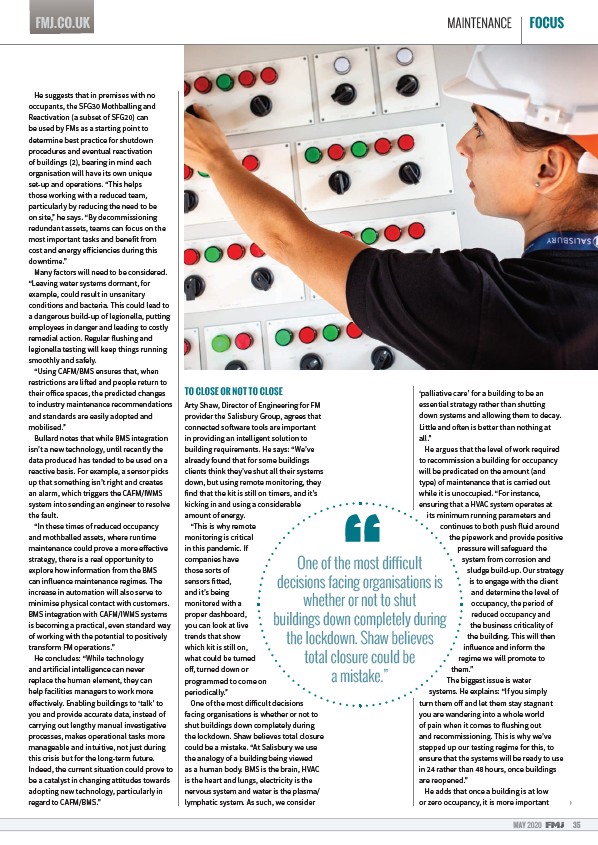
FMJ.CO.UK MAINTENANCE FOCUS
MAY 2020 35
He suggests that in premises with no
occupants, the SFG30 Mothballing and
Reactivation (a subset of SFG20) can
be used by FMs as a starting point to
determine best practice for shutdown
procedures and eventual reactivation
of buildings (2), bearing in mind each
organisation will have its own unique
set-up and operations. “This helps
those working with a reduced team,
particularly by reducing the need to be
on site,” he says. “By decommissioning
redundant assets, teams can focus on the
most important tasks and benefit from
cost and energy e iciencies during this
downtime.”
Many factors will need to be considered.
“Leaving water systems dormant, for
example, could result in unsanitary
conditions and bacteria. This could lead to
a dangerous build-up of legionella, putting
employees in danger and leading to costly
remedial action. Regular flushing and
legionella testing will keep things running
smoothly and safely.
“Using CAFM/BMS ensures that, when
restrictions are li ed and people return to
their o ice spaces, the predicted changes
to industry maintenance recommendations
and standards are easily adopted and
mobilised.”
Bullard notes that while BMS integration
isn’t a new technology, until recently the
data produced has tended to be used on a
reactive basis. For example, a sensor picks
up that something isn’t right and creates
an alarm, which triggers the CAFM/IWMS
system into sending an engineer to resolve
the fault.
“In these times of reduced occupancy
and mothballed assets, where runtime
maintenance could prove a more e ective
strategy, there is a real opportunity to
explore how information from the BMS
can influence maintenance regimes. The
increase in automation will also serve to
minimise physical contact with customers.
BMS integration with CAFM/IWMS systems
is becoming a practical, even standard way
of working with the potential to positively
transform FM operations.”
He concludes: “While technology
and artificial intelligence can never
replace the human element, they can
help facilities managers to work more
e ectively. Enabling buildings to ‘talk’ to
you and provide accurate data, instead of
carrying out lengthy manual investigative
processes, makes operational tasks more
manageable and intuitive, not just during
this crisis but for the long-term future.
Indeed, the current situation could prove to
be a catalyst in changing attitudes towards
adopting new technology, particularly in
regard to CAFM/BMS.”
TO CLOSE OR NOT TO CLOSE
Arty Shaw, Director of Engineering for FM
provider the Salisbury Group, agrees that
connected so ware tools are important
in providing an intelligent solution to
building requirements. He says: “We’ve
already found that for some buildings
clients think they’ve shut all their systems
down, but using remote monitoring, they
find that the kit is still on timers, and it’s
kicking in and using a considerable
amount of energy.
“This is why remote
monitoring is critical
in this pandemic. If
companies have
those sorts of
sensors fitted,
and it’s being
monitored with a
proper dashboard,
you can look at live
trends that show
which kit is still on,
what could be turned
o , turned down or
programmed to come on
periodically.”
One of the most di icult decisions
facing organisations is whether or not to
shut buildings down completely during
the lockdown. Shaw believes total closure
could be a mistake. “At Salisbury we use
the analogy of a building being viewed
as a human body. BMS is the brain, HVAC
is the heart and lungs, electricity is the
nervous system and water is the plasma/
lymphatic system. As such, we consider
‘palliative care’ for a building to be an
essential strategy rather than shutting
down systems and allowing them to decay.
Little and o en is better than nothing at
all.”
He argues that the level of work required
to recommission a building for occupancy
will be predicated on the amount (and
type) of maintenance that is carried out
while it is unoccupied. “For instance,
ensuring that a HVAC system operates at
its minimum running parameters and
continues to both push fluid around
the pipework and provide positive
pressure will safeguard the
system from corrosion and
sludge build-up. Our strategy
is to engage with the client
and determine the level of
occupancy, the period of
reduced occupancy and
the business criticality of
the building. This will then
influence and inform the
regime we will promote to
them.”
The biggest issue is water
One of the most diffi cult
decisions facing organisations is
buildings down completely during
the lockdown. Shaw believes
systems. He explains: “If you simply
whether or not to shut
turn them o and let them stay stagnant
you are wandering into a whole world
of pain when it comes to flushing out
and recommissioning. This is why we’ve
stepped up our testing regime for this, to
ensure that the systems will be ready to use
in 24 rather than 48 hours, once buildings
are reopened.”
He adds that once a building is at low
or zero occupancy, it is more important
total closure could be
a mistake.”